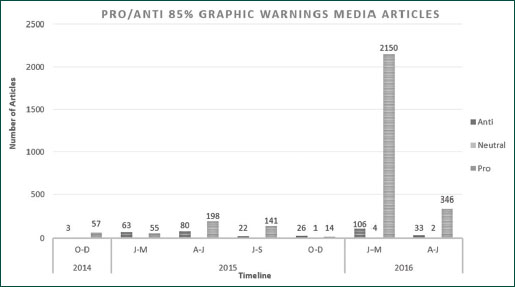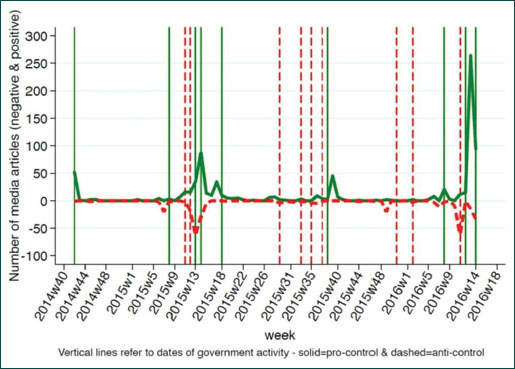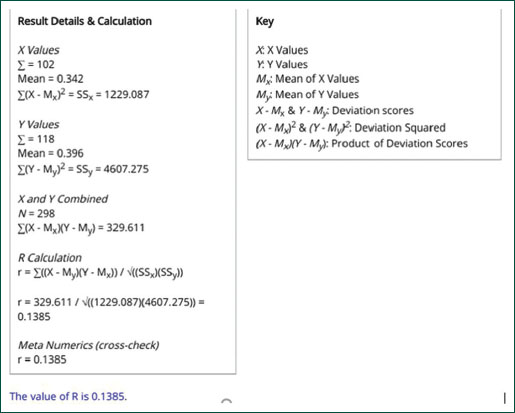Evaluating the Role of Media in Implementation of 85% Graphic Warnings on Tobacco Products in India
CC BY-NC-ND 4.0 · Indian J Med Paediatr Oncol 2020; 41(06): 879-884
DOI: DOI: 10.4103/ijmpo.ijmpo_367_20
Abstract
Background: In common with many countries globally, India has a history of graphic health warnings (GHWs) being weakened or delayed due to tobacco industry influence. If tobacco is eliminated from society, nearly 30% of all cancers can be prevented. Objectives: This study examines the role of the media in the recent changes to the 85% GHWs implementation in India. Materials and Methods: Media articles from the date of notification of 85% GHW (October 15, 2014) to the date of its implementation (April 1, 2016) were collected and coded as pro, anti, or neutral. These were compared, correlated to significant government actions during the time period to determine if media influenced the government actions on the implementation of GHWs. Results: A total of 3301 media articles regarding 85% GHWs were found during the study period, of which 2961 were pro, 333 were anti, and seven were neutral. The results showed that there was a positive correlation of media on the implementation of GHWs. Conclusion: Media coverage of the issue did appear to have an impact.
Publication History
Received: 29 July 2020
Accepted: 04 October 2020
Article published online:
14 May 2021
© 2020. Indian Society of Medical and Paediatric Oncology. This is an open access article published by Thieme under the terms of the Creative Commons Attribution-NonDerivative-NonCommercial-License, permitting copying and reproduction so long as the original work is given appropriate credit. Contents may not be used for commercial purposes, or adapted, remixed, transformed or built upon. (https://creativecommons.org/licenses/by-nc-nd/4.0/.)
Thieme Medical and Scientific Publishers Pvt. Ltd.
A-12, 2nd Floor, Sector 2, Noida-201301 UP, India
Abstract
Background: In common with many countries globally, India has a history of graphic health warnings (GHWs) being weakened or delayed due to tobacco industry influence. If tobacco is eliminated from society, nearly 30% of all cancers can be prevented. Objectives: This study examines the role of the media in the recent changes to the 85% GHWs implementation in India. Materials and Methods: Media articles from the date of notification of 85% GHW (October 15, 2014) to the date of its implementation (April 1, 2016) were collected and coded as pro, anti, or neutral. These were compared, correlated to significant government actions during the time period to determine if media influenced the government actions on the implementation of GHWs. Results: A total of 3301 media articles regarding 85% GHWs were found during the study period, of which 2961 were pro, 333 were anti, and seven were neutral. The results showed that there was a positive correlation of media on the implementation of GHWs. Conclusion: Media coverage of the issue did appear to have an impact.
Introduction
Graphic warnings on tobacco products are one of the most effective policies to prevent tobacco use initiation, particularly for illiterate population.[1] The Global Adult Tobacco Survey 2017 showed that 28.6% of people aged 15+ consume tobacco in India.[2],[3] There is substantial global evidence which demonstrates that large graphic health warnings (GHW) are a cost-effective method to communicate the health risks.[4],[5],[6]
Globally, delays in the implementation of GHWs are common. The first GHWs were introduced in Iceland in 1985. Aware of their effectiveness, the tobacco industry (TI) launched a global strategy which successfully prevented their introduction until 2000, when Canada became the second country to introduce them.[7] In Canada and other countries that followed such as Brazil and Australia, there were significant delays.[8] Implementation has continued to be a challenge due to TI opposition, especially in low- and middle-income countries such as India.[9],[10]
GHWs covered 40% of the front panel of tobacco products in India from 2008.[11] On October 15, 2014, the Indian Ministry of Health and Family Welfare (MoHFW) amended the 2008 Packaging and Labeling Rules to increase the GHW size on all tobacco products to 85%,[12] a decision which would see India ranked third globally in terms of size warnings.[13] The amendment was due to come into effect from April 1, 2015. However, on March 31, 2015, it was stalled indefinitely at the behest of a Parliamentary Committee, ostensibly to allow further discussion with stakeholders.[11] The amendment was finally implemented on April 1, 2016.[12] Between promulgation and eventual implementation, the issue was covered widely by media, with many groups, both in favor of and against the new rules, involved in the debate and quoted by media. Stakeholders included central and state governments, activists, doctors' associations, farmers' groups, trade and industry associations, and the parliament.
Legal action was also taken by the industry, which filed cases in various state high courts (HCs). Support from media or lack, thereof, can have a significant influence on government actions.[14] Within the Indian public health community, it is widely believed that media plays a role in policy-making.[15] However, to date, there has been no data-driven study on the role of the media in tobacco control policy-making. This research paper analyzes print and online media coverage and government action for and against the larger health warnings for the period between the day new rule was announced (October 15, 2014) and the day it came into effect (April 1, 2016), i.e., implementation.
Materials and Methods
The articles were collected through public relations (PR) agency “Comma Communications Management,” which tracked daily news related to tobacco within India on many tobacco-related issues such as advertising, promotion, pack labelling and warnings, Goods and Services Tax, and Illicit trade between October 15, 2014 and April 4, 2016.
In the present study, selected cities representative of national picture of tobacco consumption, the PR agency collected news daily from all papers and online 10 states and 1 Union Territory of India (Andhra Pradesh, Assam, Bihar, Chandigarh, Delhi, Karnataka, Kerala, Maharashtra, Rajasthan, Tamil Nadu, and Uttar Pradesh) on the issue of tobacco.
The articles of the English language were considered for the study. These articles were manually screened on the issue of 85% GHWs, which included tobacco-related news articles on policy, from all newspapers, online media daily, and all clips on GHWs from daily E-mails (n-507). Study also included major news agency articles on the issue of 85% graphic warnings through Press Trust of India, United News of India, Indo-Asian News Service, and Asian News International.[16]
Media articles E-mails from Comma were entered in Microsoft Excel sheet by date with headlines, page number, edition, newspaper/media outlet name, and the classification of the article as in favor of pro, against anti, or neutral [Table 1].
|
Pro article |
Anti-article |
Neutral article |
|---|---|---|
|
GHWs – Graphic health warnings |
||
|
Included statements/viewpoints in favour of 85% GHWs |
Included statements/arguments/viewpoints anti 85% GHWs |
Included balance of pro and anti-statements/viewpoints/arguments |
|
Typically from public health community and/or supportive Government Ministers |
Typically from tobacco industry, Ministers/ Members of Parliament anti 85% |
Typically from tobacco control and tobacco industry statements |

| Figure.1:Media articles classification and volume
In the implementation of the 85% graphic warnings, both the pro and anti-forces were the most active during March 2016. All syndicated articles were pro, and most were immediately before and after the actual implementation date of April 1, 2016. Syndicated articles were captured at three intervals of time: June-September 2015 62/141, January-March 2016 1823/2150 and April–June 2016 252/346 syndicated articles. The majority of April-June 2016 articles were published in the first 4 days of April [Table 2] and [Figure 2].

| Figure.2:Timeline and government events
|
S.No. |
Date |
Government actions/events |
Pro/anti |
|---|---|---|---|
|
CoSL – Committee on subordinate legislation; GHWs-Graphic health warnings |
|||
|
1 |
15-Oct-14 |
Notification of 85% PW |
Pro event |
|
2 |
25-Feb-15 |
Union Health Minister gave a statement in media in favour of the Graphic Warnings |
Pro event |
|
3 |
18-Mar-15 |
Committee on Subordinate Legislation [a Parliamentary Committee wrote to the Health Ministry to hold large GHWs] |
Anti-event |
|
4 |
23-Mar-15 |
Graphic Warnings put on hold |
Anti-event |
|
5 |
25-Mar-15 |
Union Health Minister made a statement in favour of 85% graphic warnings |
Pro event |
|
6 |
03-Apr-15 |
Union Health Minister made a statement in favour of 85% graphic warnings |
Pro event |
|
7 |
05-Apr-15 |
Statement by the Prime Minister of India on graphic warnings [Prime Minister is running the Nation, hence, an assurance that this will be implemented] |
Pro event |
|
8 |
01-May-15 |
Union Finance Minister made a statement that Govt supports graphic warnings [Second- most powerful Minister in the country] |
Pro event |
|
9 |
16-Jul-15 |
Delay Strategy: Committee on Subordinate Legislation (CoSL) asked to meet with Civil societies for implementation of 85% graphic warnings |
Anti-event |
|
10 |
19-Aug-15 |
Union Health Minister maintains status quo on 85% graphic warnings [Health Ministry maintains status quo on GHW] |
Anti-event |
|
11 |
27-Aug-15 |
Affidavit submitted to the Rajasthan High Court asking for 6-months extension. [Delay from the Government] |
Anti-event |
|
12 |
10-Sep-15 |
CoSL (Parliamentary Committee) gave report to hold GHW |
Anti-event |
|
13 |
25-Sep-15 |
Graphic Warnings to be implemented on 1st April 2016 |
Pro event |
|
14 |
18-Dec-15 |
CoSL (Parliamentary Committee) seeks clarification on 85% GHW from Health Ministry |
Anti-event |
|
15 |
08-Jan-16 |
CoSL seeks clarification on 85% GHW from Health Ministry |
Anti-event |
|
16 |
19-Feb-16 |
Union Health Ministry issued public notice about 85% Graphic Warnings implementation from April 1,2016 |
Pro event |
|
17 |
11-Mar-16 |
CoSL members deny 85% GHW stating that it is too harsh for tobacco industry |
Anti-event |
|
18 |
16-Mar-16 |
Union Health Ministry made a statement that it will not change the course of warnings and will stick to the large GHWs |
Pro event |
|
19 |
01-Apr-16 |
Graphic Warnings implemented from 1st April 2016 |
Pro event |

| Figure.3:Correlation media and government event
Media coverage is 92% times less likely to have government events occurred during the study period (odds ratio 0.08, 95% confidence interval 0.04–0.19). Thus, media is less likely to influence government events. We also studied the impact of government events on media articles. On regression analysis, government events leading to media articles were present in 43.9% of the cases. Thus, suggesting that media acts as an instrument to inform public in the times when the government events were on rise [Table 3].
|
Government events occurred during study period |
P |
||||
|---|---|---|---|---|---|
|
Category of events |
No event(%) |
Pro event(%) |
Anti-event(%) |
||
|
Media events occurred during study period |
No event |
9(9.5) |
12(42.9) |
25(65.8) |
<0> |
|
Pro event |
26(27.4) |
5(17.9) |
3(7.9) |
||
|
Anti-event |
60(63.2) |
11(39.3) |
10(26.3) |
||

| Figure.1:Media articles classification and volume

| Figure.2:Timeline and government events

| Figure.3:Correlation media and government event
References
- Rahman MM, Arif MT, Abd RM, Suhaili MR, Tambi Z, Akoi C. et al. Effectiveness of pictorial health warning on cigarette packages: A cross-sectional study in Sarawak, Malaysia. Malays Fam Physician 2015; 10: 19-26
- World Health Organization Global Adult Tobacco Survey 2017, Ministry of Health & FamilyWelfare. Available from: https://www.who.int/tobacco/surveillance/survey/gats/GATS_India_2016-17_FactSheet.pdf?ua=1. [Last acessed on 2019 Mar 01].
- Patel DR. Smoking and Children. Indian J Pediatr 1999; 66: 817-24
- Monárrez-Espino J, Liu B, Greiner F, Bremberg S, Galanti R. Systematic review of the effect of pictorial warnings on cigarette packages in smoking behavior. Am J Public Health 2014; 104: e11-30
- TC Project. Pictorial Health Warnings in India: Why Larger Warnings Should be Implemented Without Delay. ITC Fact Sheet #1 2015. University of Waterloo, Waterloo, Ontario, Canada. Available from: https://itcproject.org/files/India_WL_Fact_Sheet_Draft-May26-FINAL-V2.pdf. [Last accessed on 2019 Feb 27].
- World Health Organization. Conference of the Parties to the WHO FCTC, Guidelines for Implementation of Article 11 of the WHO Framework Convention on Tobacco Control (Packaging and labelling of tobacco products). World Health Organization; 2008. Available from: https://www.who.int/fctc/guidelines/adopted/article_11/en/. [Last accessed on 2019 Mar 06].
- Hiilamo H, Crosbie E, Glantz SA. The evolution of health warning labels on cigarette packs: The role of precedents, and tobacco industry strategies to block diffusion. Tob Control 2014; 23: e2
- Miller CL, Hill D, Quester PG, Hiller JE. Response of mass media, tobacco industry and smokers to the introduction of graphic cigarette pack warnings in Australia. Europ J Public Health 2009; 19: 644-9
- Oswal KC, Pednekar MS, Gupta PC. Tobacco industry interference for pictorial warnings. Indian J Cancer 2010; 47 Suppl 1: 101-4
- Gilmore AB, Fooks G, Drope J, Bialous SA, Jackson RR. Exposing and addressing tobacco industry conduct in low-income and middle-income countries. Lancet 2015; 385: 1029-43
- Sarin A, Janardhanan R. India: The long road to 85% tobacco pack warnings. BMJ Tobacco Control News Analysis 2017; 26: 362-63
- Ministry of Health and Family Welfare, Government of India, the Cigarettes and Other Tobacco Products (Packaging and Labelling) Amendment Rules; 2014. Available from: http://www.tobaccolabels.ca/wp/wp-content/uploads/2014/11/India-2014-Cigarettes-and-other-Tobacco-Products-Amendment-Rules1.pdf. [Last accessed on 2019 Mar 04].
- ;Cigarette Package Health Warnings, Canadian Cancer Society; October, 2016. Available from: http://www.tobaccolabels.ca/wp/wp-content/uploads/2016/11/Cigarette-Package-Health-Warnings-International-Status-Report-English-CCS-Oct-2016. pdf. [Last accessed on 2019 Mar 05].
- Understanding Media and Culture: An Introduction to Mass Communication; 2016. Available from: https://open.lib.umn.edu/mediaandculture/chapter/15-7-media-influence-on-laws-and-government/. [Last accessed 2019 Dec 25].
- Ashraf P. The role of media in good governance: Paid news culture of media and the challenges to Indian democracy. Int Res J Soc Sci 2014; 3: 41-3
- ;News Agency Journalism. Available from: https://www.britannica.com/topic/news-agency. [Last accessed on 2020 Jan 18].
- Anand P, Kunnumakara AB, Sundaram C, Harikumar KB, Tharakan ST, Lai OS. et al. Cancer is a preventable disease that requires major lifestyle changes. Pharm Res 2008; 25: 2097-116
- The Indian Express. Available from: https://indianexpress.com/article/explained/supreme-court-tobacco-packet-warning-tobacco-pictorial-warnings-2791062/. [Last accessed on 2019 Mar 07].


 PDF
PDF  Views
Views  Share
Share

